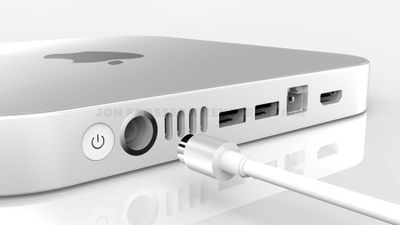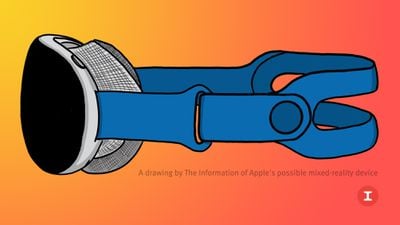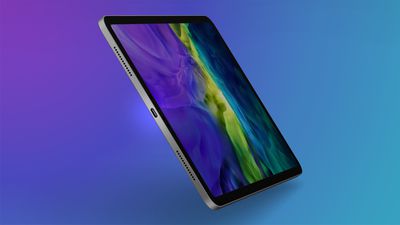There are some exciting products on the horizon for 2022 if rumors are to be believed, including the first iPhone without a notch, a larger iMac with a mini-LED display and Apple silicon chip, an entirely overhauled MacBook Air, and maybe even Apple’s first new wearable since the Apple Watch — the long-rumored AR/VR headset.
In this guide, we’ve rounded up all of the products that we could see from Apple in 2022 based on current rumors and past release information.
If current rumors pan out, 2022 could be the year that we get an all-display notch-free iPhone. Rumors suggest that a high-end version of the iPhone 14 will have a hole-punch cutout for the camera and Face ID components that are located under the display.

This would allow for the elimination of the notch, but at this early point, it’s not a sure thing and Apple’s plans could change. We’re once again expecting four iPhones, but this year, there’s not going to be a “mini” iPhone with Apple doing away with the 5.4-inch iPhone mini.
Instead, we’ll see a 6.1-inch iPhone 14, a 6.1-inch iPhone 14 Pro, a 6.7-inch iPhone 14 “Max,” and a 6.7-inch iPhone 14 Pro Max, with the “mini” size replaced by a larger “Max” size. All displays in 2022 might have 120Hz “ProMotion” technology, reserved for the iPhone 13 Pro models now.
Apple might use titanium as a material for some of the upcoming iPhones, and one rumor says we could see a thicker body that allows for the elimination of the camera bump, with the lenses, flash, and LiDAR Scanner sitting flush with the rear glass.
As for the camera, we’re expecting improvements to the Ultra Wide lens, and there’s a possibility the iPhone 14 could get a “periscope” lens that allows for greater optical zoom, but it’s not clear if this is slated for 2022 or 2023.
Apple will use an updated A16 chip in the iPhone 14, and each new A-series chip iteration brings improvements in power and efficiency. The new iPhones will feature updated X65 5G chips from Qualcomm with faster connectivity speeds. The new Qualcomm chip could power a satellite-based emergency feature that would let users send texts in emergency situations and report emergencies in areas where there is no cellular coverage.
Other features may include up to 2TB of storage space and faster WiFi 6E connectivity, with a full rundown available in our iPhone 14 roundup.
We didn’t get any new health features with the Apple Watch Series 7, but that may be changing with the Apple Watch Series 8. Apple is working on features that include blood glucose monitoring, blood pressure measurements, temperature sensing, and sleep apnea detection.
It’s not yet clear if all of these health features are coming in the Series 8, but we could get at least some of them. Temperature sensing seems likely, and it could be used for fertility and sleep tracking. Blood pressure monitoring and blood glucose monitoring are more advanced and could take more time.

Car crash detection is also a possibility, and it would build on the fall detection features that are already available with the Apple Watch. Crash detection would automatically dial emergency services in the event of a crash, using accelerometers and other sensors.
At least one version of the Apple Watch Series 8 could be marketed as “rugged,” with the device aimed at athletes, hikers, and others who use the Apple Watch in more extreme conditions. It will feature improved impact resistance and protection.
We don’t know anything about the design of the Series 8, but since the Apple Watch Series 7 just got a size update and design tweak, the Series 8 could focus on internal improvements. That said, many of the Series 7 rumors pointed toward a flat-edged design that didn’t end up happening, so we could get that design change with the Series 8.
Apple is also rumored to be working on an updated version of the Apple Watch SE to launch alongside the Apple Watch Series 8, but we don’t yet know what features might be added to the new Apple Watch SE.
Second-generation AirPods Pro are in the works and set to launch in 2022, and there are some design changes coming. Rumors suggest Apple could perhaps do away with the stem on the earbuds, with the AirPods Pro 2 featuring a more rounded shape similar to the Google Pixel Buds or Samsung Galaxy Buds.

Though a new design could be coming, it’s not a sure thing and Apple has been having trouble getting the hardware of the AirPods Pro into a smaller package.
Other than prospective design changes, the AirPods Pro are expected to offer all of the same features as the original AirPods Pro, though there could be unspecified fitness-related improvements. We don’t yet know just when the AirPods Pro 2 might debut, but we could be looking at a third quarter launch.
In 2022, we’re expecting a new version of the iPhone SE. Early rumors about the next iPhone SE suggested it could have a larger display, but that’s no longer happening this year.
Rumors indicate that the 2022 iPhone SE will feature the same design as the current iPhone SE, which is modeled after the iPhone 8. The upcoming iPhone SE will feature a 4.7-inch display, thick top and bottom bezels, and a Touch ID Home button.

Though the iPhone SE will use an older design, it will continue to appeal to those who prefer Touch ID. It is expected to include an A14 or A15 processor and a 5G modem, with Apple analyst Ming-Chi Kuo calling it the most affordable 5G iPhone available.
There won’t be a size increase, but Apple might still call the next iPhone SE the “iPhone SE Plus” because of the 5G connectivity. Apple might change the name to reflect the faster speeds.
Apple is expected to continue to sell the iPhone SE for $399, and a launch could come in the first half of the year.
In 2022, the MacBook Air is going to get the most radical redesign we’ve seen since 2010. Apple is doing away with the wedge design, and the new machine will have no taper, instead featuring a look similar to the MacBook Pro.

Apple plans to make the MacBook Air thinner and lighter than the current version, and it is going to adopt design elements from the 24-inch iMac. The bezels and the keyboard are expected to be an off-white color, while the chassis will come in a rainbow of iMac-like colors.
The MacBook Air could feature a mini-LED display similar to the MacBook Pro, but with no ProMotion technology. It’s not yet entirely clear if there will be a notch, but at least one rumor says we can expect it. It is also expected to have a MacBook Pro-like keyboard with full-size function keys and a 1080p camera.

As for ports, it will feature multiple USB-C/Thunderbolt pots, but it will not have the SD card slot or HDMI port that have been included on the MacBook Pro.
The MacBook Air is expected to feature a next-generation version of the M1 chip called the M2. It won’t be as powerful as the M1 Pro and M1 Max chips that are used in the MacBook Pro models, but it will be an upgrade to the M1.
The M2 chip is said to feature the same number of computing cores as the M1 (eight), but it is expected to feature speed improvements. It could also have improved graphics with nine or 10 GPU cores, up from seven or eight in the current M1 MacBook Air.
We don’t know exactly when the MacBook Air is going to launch, but mass production is expected in the late second quarter or early third quarter, which will perhaps see a debut in August or September.
Apple in 2021 introduced a new version of the 24-inch iMac, but there’s also a refresh of the larger 27-inch iMac on the horizon too.
The smaller iMac went from 21 inches to 24 inches, but the 27-inch iMac isn’t going to get a size increase, according to current rumors. It’s expected to feature a 27-inch mini-LED display with slim black bezels and a design similar to the Pro Display XDR.

The mini-LED display is expected to support 120Hz ProMotion refresh rates, and while Apple has tested Face ID, it’s not a sure thing as of yet. Port wise, the new iMac will likely offer a similar port configuration to the MacBook Pro, and it’s also expected to use the same M1 Pro and M1 Max chip options.
The M1 Pro features up to 16 graphics cores, while the M1 Max features up to 32 graphics cores, and these chips will also be appropriate for the iMac. To differentiate the upcoming larger iMac from the 24-inch iMac, Apple may name it the “iMac Pro.” The iMac Pro is rumored to be launching in the spring of 2022, so it could come at a March event.
The next version of the Mac mini could feature an updated design. It will still have the same square shape as the current Mac mini, but Apple may slim down the size and make part of it out of a new material.

Rumors suggest it will have a “plexiglass-like top” that will sit over the aluminum enclosure, with two-tone color options a possibility.

The upcoming Mac mini is expected to use the same M1 Pro and M1 Max chips that were first introduced in the 2021 MacBook Pro models, and it will feature a total of four Thunderbolt ports, up from two. Other ports will include a pair of USB-A ports, an Ethernet port, an HDMI port, and a port for a magnetic charging cable.
Apple’s Mac Pro models are still using Intel chips, and 2022 may be the year that Apple is able to transition its high-end desktop machine to Apple silicon.

There are two new versions of the Mac Pro in the works. Rumors suggest that one will be a direct successor to the 2019 Mac Pro that introduced a new modular design, with no major changes to the enclosure.
The second Mac Pro in development will have a smaller form factor that’s similar to the current design, but with a more compact enclosure that’s approximately half the size.
The smaller Mac Pro will have a mostly aluminum exterior, and Bloomberg has described the design as one that could “invoke nostalgia” for the Power Mac G4 Cube.
Apple’s larger Mac Pro will reportedly continue to feature Intel chips inside, with Apple perhaps planning to use Ice Lake SP chips. Apple plans to transition its entire Mac lineup to Apple silicon, but early versions of the Mac Pro chips may not be able to compete with Intel’s processors for heavy duty professional workloads.
The smaller Mac Pro will use high-end Apple silicon chips with 20 or 40 computing cores and 64 to 128-core GPUs. At the top of the line, the graphics chips would be several times faster than graphics modules Apple has used from Nvidia and AMD.
The Information has said that the Mac Pro will use an M1 Max chip with at least two dies, allowing for more compute cores. We don’t know when new Mac Pro models might launch, but sometime in 2022 seems likely.
Apple has been working on augmented and virtual reality devices for years now, and the first AR/VR (or “mixed reality”) headset is rumored to be launching at the end of 2022. The headset is said to look somewhat similar to Facebook’s Oculus Quest virtual reality headset, but with a sleeker design that uses fabrics and lightweight materials for a comfortable fit.

It will apparently feature two 4K micro-OLED displays from Sony, along with multiple sensors and more than a dozen cameras for mapping surfaces, edges, and dimensions of rooms as well as tracking hand movements. Apple analyst Ming-Chi Kuo has said that it will use 15 optical camera modules with eight used for augmented reality experiences and another six used for “innovative biometrics.”
Apple is working on multiple control methods, including a thimble-like device worn on the finger. The headset will be able to track eye movements and hand gestures, and there could also be physical controls.
Rumors suggest the headset will be equipped with a chip that’s similar to the M1 in Apple silicon Macs, and that it will be able to operate independently without being tethered to an iPhone or other Apple device. Apple plans to create an App Store for the headset, offering games, streaming video content, and more.
Apple’s AR/VR headset is expected to be expensive, priced at around $3,000. We don’t know a specific launch date as of yet, but it’s said to be launching at the end of the year.
We’re expecting a new version of the iPad Pro in 2022, likely with the same 11 and 12.9-inch size options. The 11-inch model could be updated with the same mini-LED display that was introduced in the 12.9-inch model, and Apple is rumored to be planning to include a glass back to support wireless charging.

The 2022 iPad Pro may get a MagSafe charger, similar to the charger that’s used for the iPhone 12 and 13 models, and there could also be a reverse wireless charging feature. Reverse wireless charging would allow the iPad Pro to charge other devices like the iPhone or AirPods.
The new iPad Pro models will also get an updated A-series chip, using the latest technology from TSMC. Leaker Dylandkt has claimed that the next iPad Pro could feature a horizontal camera alignment and a landscape-oriented Apple logo on the back, a change meant to promote usage of the iPad in landscape mode instead of portrait mode.
There have been other iPad Pro rumors suggesting we could see OLED displays, a new Apple Pencil, and perhaps a titanium chassis, but it’s not clear if this information will pan out.
Apple is working on an updated version of the Pro Display XDR and other lower-cost Apple-branded display options that are expected to be sold alongside it. Apple could release a 24-inch display, a 27-inch display, and a 32-inch Pro Display XDR successor, and these display options could come out at some point in 2022.
Other Updates
We haven’t heard much about refreshes for other devices, but there are products that Apple typically updates on a yearly or bi-yearly basis, so we could see updates for the following products:
Wrap Up
Based on what we know so far, Apple has some exciting announcements in the works for 2022, and we could see some surprises as well. Make sure to follow MacRumors.com and the MacRumors roundups and guides over the course of 2022 to keep up with the rumors we’re hearing, and bookmark our What to Expect Guide and our Events Guide to see a continually updated overview of what’s ahead.
Stay connected with us on social media platform for instant update click here to join our Twitter, & Facebook
We are now on Telegram. Click here to join our channel (@TechiUpdate) and stay updated with the latest Technology headlines.
For all the latest For Top Stories News Click Here
